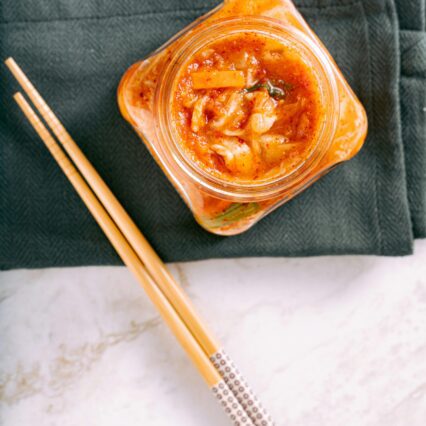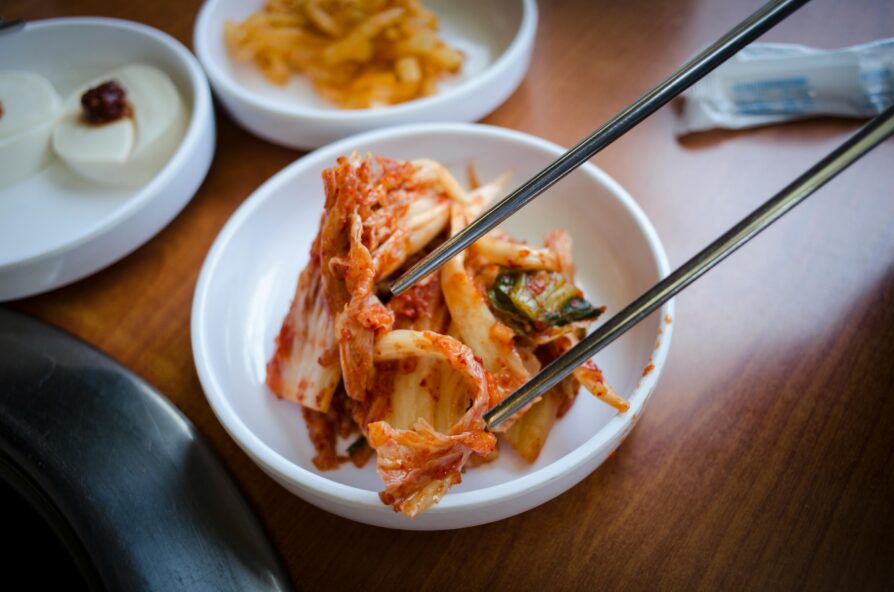What is Kimchi & How to Make it at Home

What is Kimchi & How to Make it at Home
Before We Dive Into It, Some of the Endless Types of Kimchi for Your Inspiration
You surely are familiar with kimchi if you decided to read this. As a dish that is, at its most basic, simply fermented vegetables (and usually gochugaru Korean chili pepper spice), there are a boatload of different types of kimchi.
The most famous is of course based on napa cabbage — that’s baechu kimchi — but there is also:
Baek Kimchi: This is also made of napa cabbage, but unlike baechu kimchi it omits the gochugaru chili powder. Without the spice, the other flavoring ingredients and fermentation taste become more of a focus.
Oi Sabogi Kimchi: Stuffed cucumber kimchi made of small cucumbers sliced into chunks and stuffed with shredded vegetables and aromatics. These are made to be eaten right away unlike baechu kimchi which can last for months on end in the fridge. Oi sabogi kimchi is refreshing and crunchy.
Khakdugi Kimchi and Chonggak Kimchi: Both of these are made with radishes, but khakdugi is made with cubed radish while chonggak is made of ponytail radish. A standard Korean radish is simply chopped into cubes for khakdugi, while chonggak kimchi’s ponytail radishes are much smaller and fermented whole or sliced lengthwise — complete with their green stem!
Gat Kimchi: The primary ingredient here is mustard leaves, giving gat kimchi an extra peppery bite. Along with the gochugaru and aromatics, the brine also includes pickled anchovy paste which creates a further umami flavor and aroma.
Nabak Kimchi: AKA red water kimchi — the brine for this is different than for other kimchi types, including Korean pear juice along with garlic, aromatics, and just a pinch of gochugaru pepper. The pickled vegetables usually include radish, sliced carrot, green onion, and napa cabbage. The taste emphasis for nabak kimchi is just a hint of spice, but otherwise relatively mild.
This list is of course not exhaustive, but we find it’s a good place to start. Also a good place to start:
The Benefits and Why You Should Eat It
Just like so many vegetable-based and fermented foods, kimchi has a lot of health benefits!
For starters, it’s packed with a lot of vitamins and minerals, particularly C and Bs, iron, and many (although not all) of the electrolytes like potassium, sodium, and calcium. It also is a good source of dietary fiber — as most vegetable based foods are — although some types are more so than others, as you can imagine due to how different types contain different veggies of various fiber levels.
Similarly, the gochugaru chili flakes present in almost all types of kimchi is known to help metabolism and move along digestion among other benefits, but in a way that is less… “aggressive” than other foods which may include a more liberal dousing of chili powder.
Along with the health benefits of the ingredients themselves, the act of fermentation provides a whole other layer. Namely, kimchi is loaded with “good” bacteria, which have significant implications not just for your gut health, but your everything health.
Fermented foods’ effect on your internal microbiome have shown to improve your digestion and nutrient absorption, your immune system, your skin health and has been shown to help lower certain inflammatory proteins. There are further implications for arthritis, diabetes, and stress-related effects, too. (If you’d like to learn more about some of these findings, their magnitude, and the nuances, here’s a fascinating look at one study from Stanford Medicine!)
While research about the microbiome is constantly unveiling more of these nuances regarding what role it plays and how it works, there’s growing evidence that a diet rich in fermented foods can improve many aspects of our health.
We of course can’t make claims about how fermented foods will magically give you Fabio hair, make your crush like you, and increase your salary by 50%, but there are a lot of implications of which we’re learning more and more that are pretty dang compelling.
Making Baechu Kimchi at Home
As for making your own kimchi, here’s a good basic starting point.
The process follows the same principles as all lacto-fermented vegetable foods, so you can customize the base ingredients pretty liberally. Some might want to add some white onions or sliced carrots, for example. Regardless, they’re all common ingredients which you can always find at Uwajimaya. 
The Vegetable and Aromatic Ingredients:
- Napa cabbage
- Scallions/green onions, chopped into one- to three-inch bits
- Garlic
- Ginger
Brine and Flavoring Ingredients:
- Non-iodized salt
- Sugar
- Fish sauce and/or shrimp paste
- Gochugaru chili powder
From there, the steps are pretty simple: Simply chop the cabbage into kimchi-sized pieces and rinse, then salt the chopped pieces and mix in the salt liberally. (A large salad bowl or something similar can be helpful here.)
From there, some recipes will have you add water so that the cabbage is soaked in salt water instead of just the dry salt, some won’t. It’s up to you. Whichever method you choose, now leave the salted cabbage in a water-tight container or bag for six hours — once this time is up, remove the cabbage and rinse this first brine off thoroughly.
Now the cabbage is rinsed, mix the rest of the ingredients minus the gochugaru to create their “paste;” once they’re thoroughly mixed together, add the gochugaru, then massage this paste thoroughly around your cabbage. Put that into your fermentation jar, press down on the cabbage to make sure the brine is completely covering it, seal the jar, and store in a cool dry place for a few days. While you’ll likely want to ferment it for longer than that — different fermentation times create different flavors, and you can open it up and taste it daily to see if it’s reached the flavor you’re looking for — you’ve just made kimchi!
Once it’s ready, store in the fridge.
Here are a couple recipes from The Kitchn and My Korean Kitchen that show you a few different methods you can follow during the salting and other steps to make basic baechu kimchi. We recommend giving them a read if you want more details.
Overall, fermented foods are great for your overall health while being extremely tasty. Kimchi is one of the most flavorful of all of these, being refreshing and kicky, umami-filled and tangy. We might be biased, but it may just be our favorite.




